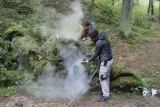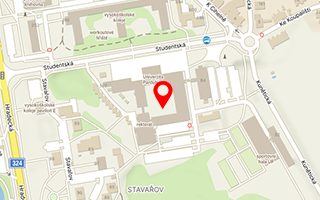Published: 13.01.2021
It is one of the top examples of Baroque landscape sculpture. And not only in our country. Hidden in the forest of Nový Les near the Kuks Hospital, it attracts thousands of visitors every year. The Nativity Scene by Matthias Bernard Braun is nearly 300 years old. Yet, despite having been able to withstand the elements for centuries, the unique sculpture carved into stone could perish in a few decades without the regular care of experts. And they are the students and experts from our Faculty of Restoration who will now take care of this national cultural monument.
The origins of this complex, which lies between the towns of Dvůr Králové nad Labem and Jaroměř, fall into the times of count Franz Anton von Sporck. The Nativity Scene was meant to become a part of his residential and spa palace. These works of art were created between 1722 and 1732. At present, they are all severely damaged due to their age, weather, climate change, and partly even vandalism. “It is probably the statute of John the Baptist which has been affected the worst, because what remains is only its torso. Also the statue of reclining Mary Magdalene is in a very bad condition,” describes the current state of the sculptures Associate Professor Jakub Ďoubal from the Faculty of Restoration, the University of Pardubice.
The statues and reliefs in Nový Les are unique in that Matthias Bernard Braun carved them into solid rock right on the spot. According to the head of the Studio of Restoration and Conservation of Stone and Related Materials, it is an extraordinary piece of work. “As to its scope, design, and sculptural conception. It is the highlight of Baroque art on a European scale,” says Jakub Ďoubal.
One wonders if an expert approaches such a piece with even greater sensitivity and caution. And whether s/he is thinking about how an important monument s/he saves. “It’s not so important if you’re restoring a national cultural monument or an ordinary cross somewhere in the fields. You’re always bound by great responsibility,” explains the restorer.
Missing parts are left incomplete, we will see a torso
The experts from the University of Pardubice have already been involved in the restoration of individual sculptures. This time, they will perform the overall maintenance of all preserved sculptures and provide subsequent regular care of them. “Our plan is to involve the students from all years of the Studio of Restoration and Conservation of Stone and Related Materials, which is about sixteen people. We should clean all the statues from vegetation and dirt, and secure their risk parts to prevent further damage to the piece of work,” says the university teacher.
It will be necessary to strengthen the eroded parts and secure all fissures to prevent the separation and loss of their parts. In doing so, the experts draw on their experience in previous maintenance and the NAKI project of the Ministry of Culture. The output of the project, led by the Faculty of Restoration, is mainly the possibility of cleaning and setting up the long-term care, including the possibility of slowing down the growth of algae, mosses and lichens on the stone surface.
The restorers will not complete the missing parts of the monument but only preserve it. “Braun’s Nativity Scene will be presented in its ruinous form even after the restoration. The degree of cleaning will be chosen so that the relief stands out and no damage occurs. At the same time, we’d like to maintain a certain degree of patina,” explains Associate Professor Ďoubal. He thinks that a restorer should always discuss with conservationists and the administrator of the site how to present the work as well as what the main values are, which s/he should do her/his best to preserve.
Slow down the growth of mosses, prolong lifetime
The most important thing for the experts is to prolong the lifetime of this extremely important monument as much as possible. “The best strategy is to provide regular maintenance and monitoring, which enables us to respond to current situation in time. It’s much better than the steps taken in many other cases – that is to leave the monument to its fate and when it eventually comes to the state of emergency, perform a large and expensive reconstruction,” says the expert.
The restorers will check the monument every year. They will evaluate its state, perform final cleaning if necessary, and apply protective biocidal spraying. This should slow down the growth of mosses and lichens. The mapping should result in further steps and restoration interventions on specific works.
Originally, the set of the sculptures was a part of the whole complex of buildings and landscape elements, of which only a part has survived to this day. The sculptures in Nový Les near Kuks were complemented by other buildings and sculptural works. However, many of the buildings have disappeared – among them also the chapels of the Finding of the Holy Cross and the Exaltation of the Holy Cross. Similarly, the Hermitages of St Paul and St Anthony, including the lookout pavilion and the piscina with a fountain, have perished, too. Some of the parts have been preserved, but they have been transported elsewhere. For example, the statute of St Anthony, formerly situated by the hermitage, is currently in the museum in Jaroměř. The statue of St Jerome in the Desert has been moved by the conservationists to the garden of Kuks Hospital. Also the torso of the statutes of Hagar in the Desert and hermit Garinus’ dog have been removed to Kuks.


